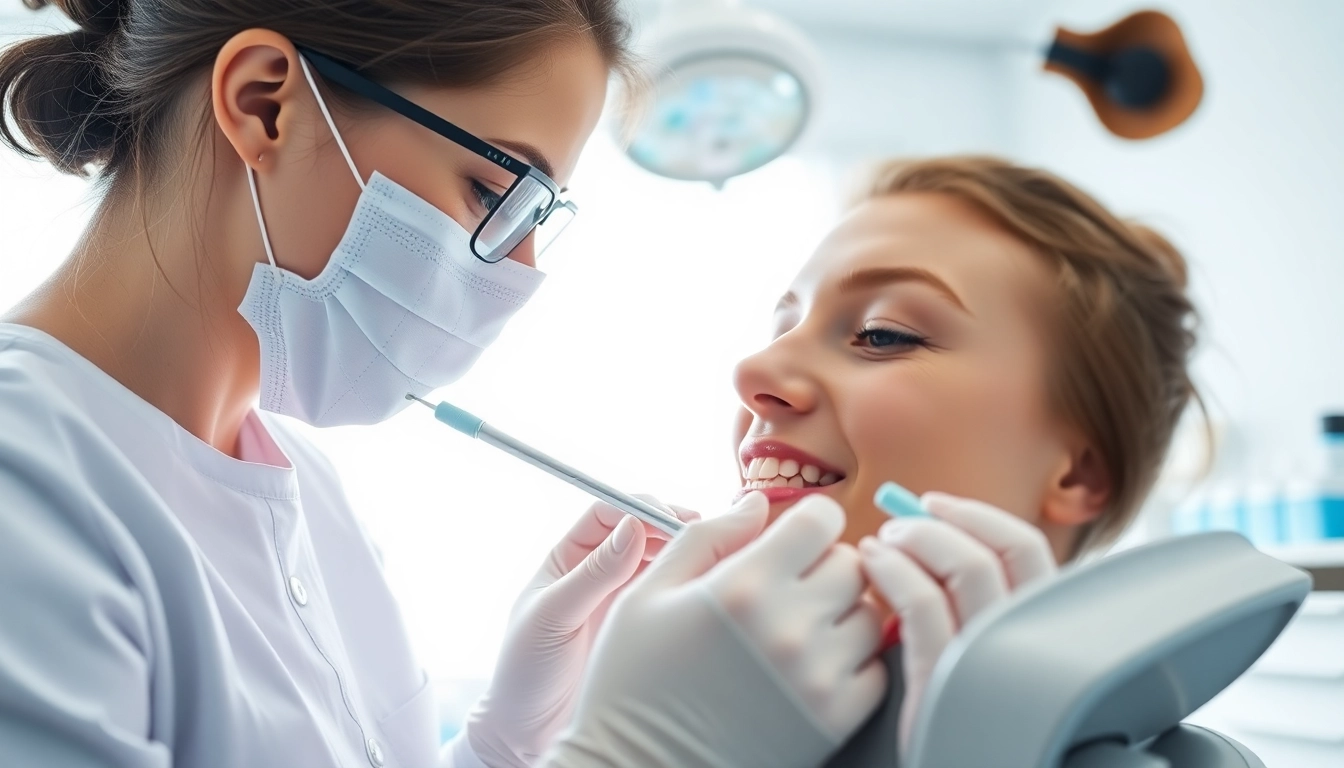
What Are Dental Cleanings?
Definition and Purpose of Dental Cleanings
Dental cleanings refer to the professional dental procedures performed by a dentist or dental hygienist to remove accumulated plaque, tartar, and debris from the teeth and gums. The primary purpose of these cleanings is to maintain oral health, prevent periodontal disease, and enhance the aesthetic appearance of the teeth. Moreover, routine dental cleanings play a crucial role in identifying potential oral health issues early on, allowing for prompt intervention and reducing the risk of serious complications, including tooth loss.
Benefits of Regular Dental Cleanings
Engaging in regular dental cleanings provides numerous benefits for overall oral health. Some notable advantages include:
- Prevention of Tooth Decay: Routine cleanings help eliminate plaque buildup, which is the primary contributor to cavities. By removing debris, patients safeguard their enamel from acid attacks.
- Gum Disease Prevention: Regular cleanings lower the risk of gingivitis and periodontitis, conditions that can lead to swollen and bleeding gums, bad breath, and eventually tooth loss.
- Whiter Smile: The professional polishing and cleaning of teeth can significantly brighten a person’s smile, enhancing their overall appearance.
- Early Detection of Oral Health Issues: During dental cleanings, dentists can spot problems such as cavities, gum disease, or oral cancer in their early stages.
- Improved Overall Health: There is a strong link between oral health and systemic health. Regular dental cleanings can reduce the risk of conditions such as heart disease and diabetes.
Common Misconceptions About Dental Cleanings
Despite their numerous benefits, there are prevailing misconceptions regarding dental cleanings. Some of these include:
- Misconception 1: Dental Cleanings Are Painful
Many fear that dental cleanings are painful, leading to anxiety before appointments. However, while some discomfort might arise from the removal of tartar, most patients find cleanings to be relatively comfortable. - Misconception 2: You Only Need Cleanings If You Have Dental Problems
Even those with great oral hygiene should continue to have regular cleanings, as they help prevent issues before they arise. - Misconception 3: At-Home Care is Enough
While daily brushing and flossing are essential, they do not eliminate all plaque and tartar. Professional cleanings are necessary for optimal dental health.
The Dental Cleaning Process Explained
Initial Examination and Consultation
The dental cleaning process begins with an initial examination. This typically includes a review of the patient’s dental and medical history, assessing the overall oral health condition, and a visual inspection of the teeth and gums. X-rays may also be taken if necessary to check for issues not visible during the examination. This preliminary step ensures that the cleaning process is tailored to the individual’s needs.
Tools and Techniques Used in Dental Cleanings
Dental hygienists utilize various tools and techniques during a cleaning session, including:
- Scaler: This hand-held tool is used to remove plaque and tartar buildup from above and below the gum line.
- Ultrasonic Cleaners: These devices utilize vibrations to break apart tartar while simultaneously flushing bacteria from the mouth.
- Polishing Tools: After scaling, a polishing tool with a soft rubber tip and special paste is used to polish the teeth, improving their appearance and making it harder for plaque to build up.
- Flossing: The hygienist will also thoroughly floss the patient’s teeth, ensuring that no debris remains in the hard-to-reach areas.
What to Expect During Your Visit
At a dental cleaning appointment, you can expect the following sequence of events:
- Check-In: Register your arrival, complete any necessary paperwork, and provide updates on your health status.
- Initial Assessment: A brief consultation with a hygienist or dentist to discuss your oral health concerns.
- Cleaning Procedure: The hygienist will begin with scaling, followed by polishing and flossing. You may experience slight discomfort, but pain should be minimal.
- Post-Cleaning Consultation: The dentist may provide a treatment plan based on findings from the cleaning and discuss any additional care needed.
Types of Dental Cleanings and When They Are Needed
Standard Cleaning vs. Deep Cleaning
There are two main types of dental cleanings: standard cleanings and deep cleanings. Understanding the differences can help determine which procedure is suitable for you.
- Standard Cleaning: Typically performed every six months for patients with healthy gums and no significant plaque buildup. Standard cleaning focuses on the surface of the teeth, effectively removing most plaque and tartar.
- Deep Cleaning: Recommended for patients showing signs of gum disease. Deep cleaning usually entails scaling and root planing, where plaque and tartar are removed from teeth below the gum line. This process involves numbing the area to ensure patient comfort during the procedure.
Specific Treatments for Gum Disease
For individuals diagnosed with gum disease, more specialized treatments may be necessary during the cleaning process. These treatments may include:
- Scaling and Root Planing: This procedure is performed to clean below the gum line thoroughly and to smooth rough surfaces of the roots, promoting healing.
- Antibiotics: In some cases, dentists may prescribe antibiotics post-cleaning to combat infection.
- Regular Follow-Ups: Patients with gum disease may require more frequent cleanings and follow-ups to monitor their condition.
Frequency Recommendations for Dental Cleanings
The recommendation for dental cleaning frequency can vary based on individual needs, but general guidelines are as follows:
- Every 6 Months: For individuals with good oral hygiene and no history of gum disease, biannual cleanings are often sufficient.
- Every 3-4 Months: Those with ongoing dental issues, such as gum disease or a history of tooth decay, may benefit from more frequent cleanings.
How to Prepare for Your Dental Cleaning
Tips for Before Your Appointment
Proper preparation can enhance your experience. Consider the following tips:
- Maintain Regular Oral Hygiene: Continue your regular brushing and flossing routine, ensuring that your mouth remains as clean as possible prior to your appointment.
- List Any Concerns: Write down any dental concerns or questions you may want to discuss with the dentist or hygienist.
- Inform Your Dentist: Update your dentist about any changes in your health status or medications you may be taking.
What to Bring to Your Dental Cleaning
When attending your appointment, ensure you have the following items ready:
- Identification and Insurance Information: If applicable, bring your dental insurance card and personal ID.
- Medical History: Any updates regarding medications or health conditions should be documented.
- Payment Method: Be prepared to settle any copays on the day of your appointment.
Questions to Ask Your Dental Hygienist
Engaging in an open dialogue with your dental hygienist can help optimize your oral care plan. Consider asking:
- What specific tools will be used during my cleaning?
- How often should I schedule my cleanings based on my current dental health?
- Are there products or techniques you recommend for my at-home oral hygiene routine?
- What signs should I look out for that indicate I need a cleaning sooner than planned?
Maintaining Oral Health Between Dental Cleanings
Daily Oral Hygiene Practices
Between dental cleanings, maintaining good oral hygiene practices is crucial. Effective daily practices include:
- Brushing Twice Daily: Use a fluoride toothpaste and a soft-bristled toothbrush to clean your teeth thoroughly.
- Flossing Daily: Flossing removes debris from between teeth that a toothbrush cannot reach, significantly reducing the risk of cavities.
- Using Mouthwash: An antimicrobial mouthwash can provide an additional layer of protection against plaque and gum disease.
Diet and Its Impact on Dental Health
What you consume directly impacts your dental health. To promote oral wellness:
- Limit Sugary Foods: Reduce intake of high-sugar snacks and beverages, as sugar contributes to cavity formation.
- Choose Nutrient-Rich Foods: Foods rich in calcium, phosphorous, and vitamins A and C can promote strong teeth and gums.
- Stay Hydrated: Drinking water helps wash away food particles and bacteria, acting as a natural cleansing agent.
Recognizing Signs That You Need a Dental Cleaning
Being aware of signs that indicate you may need a dental cleaning sooner than scheduled can be beneficial. Look for:
- Bleeding Gums: If your gums bleed during brushing or flossing, it may indicate inflammation or other gum problems.
- Persistent Bad Breath: Chronic bad breath, or halitosis, may hint at plaque buildup or underlying dental issues.
- Increased Tooth Sensitivity: Sensitivity to hot and cold foods may indicate the need for a cleaning, especially if accompanied by discomfort.
- Visible Plaque or Tartar: If you notice a film forming on your teeth or dark deposits at the gum line, seek a cleaning promptly.







